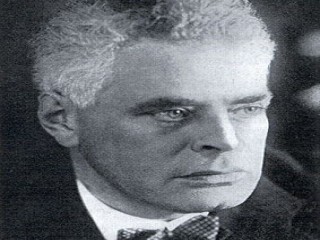
Jacobus Oud biography
Date of birth : 1890-02-09
Date of death : 1963-04-05
Birthplace : Purmerend, North Holland
Nationality : Dutch
Category : Arhitecture and Engineering
Last modified : 2011-07-05
Credited as : Architect, Kiefhoek area of Rotterdam , Shell Building in The Hague
On Feb. 9, 1890, J.J.P. Oud (Jacobus Johannes Pieter Oud) was born in Purmerend in North Holland. He studied at the Quellinus School of Arts and Crafts, the National School of Graphic Arts in Amsterdam, and the Technical University in Delft. His practical training came in the office of Cuijpers and Stuyt in Amsterdam and Theodor Fischer in Munich, but he was influenced as well by the work of H.P. Berlage and Frank Lloyd Wright. Oud's early buildings, those designed between 1906 and 1916, show a nearly total dependence upon the work of Berlage (for example, the design for a bathhouse for Purmerend, 1915). In 1917 Oud joined Theo van Doesburg and others to found de Stijl (the Style), a group of artists and architects that advocated an artistic expression, now best known from the paintings of Piet Mondrian, in which nature is abstracted into an interrelationship of rectangles of primary colors. Its journal (also called De Stijl) became the mouthpiece of modernism in the Netherlands. Oud's work now assumed the bleached, cubical forms characteristic of the new architecture of the 1920s (design for row houses, Scheveningen, 1917). He soon broke away from de Stijl.
From his position (1918-1933) as city architect for Rotterdam, where his chief concern was mass housing, Oud became a leader in the European architecture of the International Style, the Dutch counterpart of Walter Gropius in Germany and Le Corbusier in France. For the series of books issued by the Bauhaus, Gropius's school of architecture, Oud produced Hollandische Architektur (1926), which contains, among other things, an essay on the development of Dutch architecture from P.J.H. Cuijpers through Berlage to Oud himself. Oud contributed a group of low-cost row houses (1927) to the exhibition of the Werkbund, or German association of modern architects and designers, at the Weissenhof in Stuttgart. This exhibition marked the maturation of the International Style. Other outstanding works from this period in Oud's career include the facade design of asymmetrical rectangles for the Cafe de Unie in Rotterdam (1925; destroyed) and workers' housing quarters in the Hook of Holland (1924-1927) and the Kiefhoek area of Rotterdam (1924-1929). The workers' quarters show the plain stucco cubes, the efficient planning, and the social consciousness characteristic of the progressive architecture of the 1920s in Europe.
From 1933 until his death in Wassenaar on April 5, 1963, Oud practiced as an independent architect. A period of inactivity was closed with the design of the Shell Building in The Hague (1938-1942), but his work of this later period, with an occasional exception such as the Bio Health Resort in Arnhem (1952-1960), failed to go beyond the achievements of the 1920s. In 1955 he was awarded an honorary doctorate by the Technical University in Delft.
Works of Jacobus Oud:
1906 House in Purmerend.
1912 Movie theatre, block of worker housing and small individual houses in Purmerend.
1913 - 1914 Small houses in and about Leiden.
1915 Project for a municipal bath house, unexecuted.
1917 House in Katwijk-aan-Zee (collaboration with Kamerlingh Onnes). House in Noordwijkerhout (collaboration with Theo van Doesburg). Project for a row of seaside houses, unexcecuted.
1918 Spangen, Blocks I and V, Worker housing in Rotterdam.
1919 Spangen, Blocks VIII and IX. Projects for a factory and a bonded Warehouse, unexcecuted.
1920 - 1921 Tuschendijken, Blocks I to IV and VI in Rotterdam.
1921 Project for a house in Berlin, unexcecuted.
1922 Garden Village in Rotterdam at Oud-Mathenesse.
1923 Superintendent's office at Oud-Mathenesse, temporary.
1925 Café de Unie in Rotterdam
1926 Project for Hotel Stiassni in Brno, Czechoslovakia, unexcecuted. Competition project for Rotterdam Exchange, unexcecuted.
1926 - 1927 Worker's Houses at the Hoek of Holland
1927 Row of 5 houses, Weissenhof Housing Exposition, Stuttgart.
1927 Additions to the villa Allegonda at Katwijk-aan-Zee.
1928 - 1930 Kiefhoek Housing Development in Rotterdam.
1931 Project for steel apartments in Rotterdam, unexcecuted. Project for house in Pinehurst, unexecuted.
1938-1948 Shell Headquarters, The Hague
1942-1957 Spaarbank, Rotterdam
1952-1960 Bio-herstellingsoord, Arnhem
1954-1961 Officebuilding De Utrecht, Rotterdam
1956, National Monument (with sculptor John Raedecker), Dam Square, Amsterdam


















